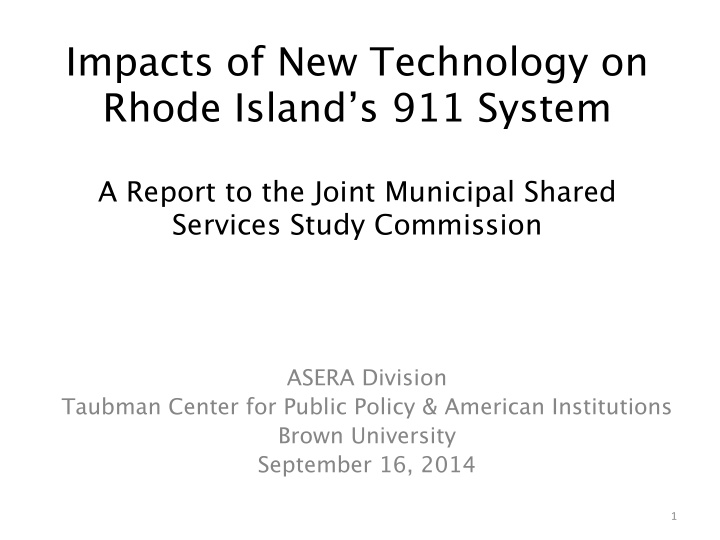



Impacts of New Technology on Rhode Island’s 911 System A Report to the Joint Municipal Shared Services Study Commission ASERA Division Taubman Center for Public Policy & American Institutions Brown University September 16, 2014 1 ¡
Charge from Commission • Comprehensive examination of the current 911 system and the impacts of new technology with regard to: • Public safety • Cost implications 2 ¡
Summary • RI’s Current System: E-911 • Coming Technology: NG-911 • Opportunities and Challenges of NG-911 • Alternative Structures for NG-911 – Horizontal Consolidation – Vertical Consolidation • Recommendations 3 ¡
E-911 • One Primary Public Safety Answering Point (PSAP)– North Scituate – All 911 calls received by North Scituate • Voice calls only – Almost all information relayed verbally – After determining the nature and location of the call, telecommunicators transfer the call to the appropriate dispatch center(s) • 72 Local Dispatch Centers – Local dispatchers send appropriate first responders 4 ¡
Figure ¡1: ¡Current ¡911 ¡System ¡ 911 ¡Caller ¡ PSAP ¡ Local ¡ Dispatch ¡ First ¡ Responder ¡ 5 ¡
NG-911 • Texts, video, pictures, other multimedia • NG-911 is coming to Rhode Island North Scituate to receive texts messages in • early 2015 • The state needs a cohesive plan for implementing NG-911 throughout the 911 system 6 ¡
Figure ¡1: ¡Current ¡911 ¡System ¡ 911 ¡Caller ¡ PSAP ¡ Local ¡ Dispatch ¡ First ¡ Responder ¡ 7 ¡
Figure ¡2: ¡Plan ¡for ¡NG-‑911 ¡ImplementaDon ¡ 8 ¡
Impact of NG-911 Drastic change to the flow of information Text or call RI 911 • All calls and texts received by PSAP • Telecommunicators must interpret text • messages and verbally relay info to dispatchers Similar to how wireless phones changed 911 • 911 technology will continue to evolve • The State must take necessary steps to: Maintain the highest level of public safety • Mitigate NG-911 State and municipal costs • 9 ¡
Challenges of NG-911 Implementation Plan Interpretation of text messages: Only telecommunicators can receive and • interpret text messages Texts may be hard to interpret due to • shorthand or ambiguous language Only telecommunicators can send texts back • and forth with 911 user for clarification, dispatchers cannot 10 ¡
NG-911 Technology at Local Dispatch Centers • Installing NG-911 technology at local dispatch centers is necessary to alleviate the challenges that arise when only the PSAP has NG-911 technology 11 ¡
Figure ¡3: ¡NG-‑911 ¡Technology ¡at ¡Local ¡Dispatch ¡Centers ¡ 12 ¡
Benefits of NG-911 at Local Level • Reduces NG-911 strain on telecommunicators ¡ • Reduces communication errors and delays between the PSAP and local dispatchers ¡ • Reversing the information flow is a vastly expedited process 13 ¡
Challenges of Implementation at Local Level • Municipal costs of implementation and upgrades at 72 municipal dispatch centers: Includes router, static IP broadband connection, • and a CAD system interoperable with the PSAP Future costs of system maintenance and • upgrades for new technology • Local dispatch centers with di fg erent NG-911 technology will not be interoperable 14 ¡
Alternative Structures to Enhance Public Safety and Mitigate Costs We evaluate system performance of two di fg erent options tailored specifically to Rhode Island: • Horizontal Consolidation • Vertical Consolidation 15 ¡
Horizontal Consolidation • Combines municipal dispatch services by criteria such as region, cooperative agreements, or financial considerations • For example, multiple municipalities may choose to combine their fire dispatch units into a single dispatch facility • Would allow municipalities to share the costs of NG-911 implementation 16 ¡
Figure ¡1: ¡Current ¡911 ¡System ¡ 17 ¡
Figure ¡4: ¡Horizontal ¡ConsolidaDon ¡with ¡NG-‑911 ¡Implemented ¡ ¡ 18 ¡
Horizontal Consolidation: Public Safety Implications E fg ectiveness of 911 System • Public safety will neither increase nor decrease Interoperability Benefits • Increased interoperability between local dispatch centers if they transition to NG-911 using the same technology 19 ¡
Horizontal Consolidation: Fiscal Implications Cost Savings • Fewer local dispatch centers, which would reduce local costs by sharing NG-911 expenses across multiple municipalities Additional Outlays • Additional upfront costs for some expanded facilities to house local dispatch centers ¡ 20 ¡
Vertical Consolidation • Create regional facilities, each of which combines PSAP and dispatch responsibilities • Telecommunicators answer 911 calls and then dispatch emergency services directly ¡ 21 ¡
Figure ¡1: ¡Current ¡911 ¡System ¡ 22 ¡
Figure ¡5: ¡VerDcal ¡ConsolidaDon ¡ 23 ¡
Vertical Consolidation: Public Safety Implications Improves public safety by removing a point of contact in the four-point transmission chain: • Decreasing transmission error • Increases speed of response Issues • Reduction of local knowledge in dispatch 24 ¡
to serve this role • Vertical Consolidation: Fiscal Implications Cost Savings • Reducing the number of facilities requiring upgrades will reduce long term costs • Combining dispatch and PSAP responsibilities into single facilities will remove a link in the 911 transmission chain Additional Outlays • Capital and infrastructure costs associated with building new PSAPs or upgrading current facilities 25 ¡ M
Recommendation Move forward with horizontal consolidation: • Reduces costs • Maintains public safety • Does not preclude moving to vertical consolidation State actions: • Regulate NG-911 technology and protocols at the dispatch level • Explore cost-sharing programs to mitigate up- front capital costs to municipalities during consolidation 26 ¡
Need for Pilot Projects Multiple pilot projects, each one combining 3-5 municipalities Criteria: • Geography (urban, suburban, rural) • Population (tourists, linguistics, density) • Call volume • Existing ties between municipalities 27 ¡
Thank you 28 ¡
Recommend
More recommend